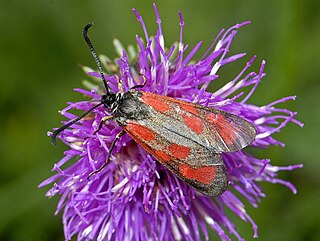
The Zygaenidae moths are a family of Lepidoptera. The majority of zygaenids are tropical, but they are nevertheless quite well represented in temperate regions. Some of the 1000 or so species are commonly known as burnet or forester moths, often qualified by the number of spots, although other families also have 'foresters'. They are also sometimes called smoky moths.

The six-spot burnet is a day-flying moth of the family Zygaenidae.

Zygaena transalpina is a moth of the family Zygaenidae.

Hippotion celerio, the vine hawk-moth or silver-striped hawk-moth, is a moth of the family Sphingidae. It was described by Carl Linnaeus in his 1758 10th edition of Systema Naturae.

Grammodes geometrica is a moth found from the Mediterranean east to Oriental and Australasian tropics of India, Sri Lanka, Java and Australia. The adult is a fruit piercer. The species was first described by Johan Christian Fabricius in 1775.

Zygaena is a genus of moths in the family Zygaenidae. These brightly coloured, day-flying moths are native to the West Palearctic.

Zygaena carniolica, sometimes described as the crepuscular burnet or eastern burnet, is a member of the family Zygaenidae.

Zygaena ephialtes is day-flying species of burnet moth found in Europe. It is typically found in xeric habitats, and populations have recently decreased. It also exhibits Müllerian mimicry with other species, like Amata phegea.

Zygaena fausta is a member of the family Zygaenidae, the day-flying burnet moths. Its bright aposematic colours of red, white and black on the wings indicate to possible predators such as birds that it is foul tasting or poisonous. In flight, the bright red abdomen is revealed, contrasting with the white legs and black head and antennae; the thorax is black and white with an eye spot on each side. There appears to be a considerable variation in pattern among specimens from different parts of Europe.

Zygaena loti, the slender Scotch burnet, is a moth of the family Zygaenidae. It is a diurnal moth characterized by a black body, light colored legs, and red spots on its wings. The caterpillars are a yellow-green color and usually molt out of dormancy in late February to early March. The larvae feed on plants from the family Fabaceae until they enter their pupal stage and mature into adults in May to early June. For mating, Zygaenidae exhibit a dual-partner finding strategy, where females use pheromones while assuming a calling position, and males exhibit a patrolling behavior where they utilize both vision and the olfactory receptors in their antennae to locate a potential mate. Although regionally endangered as their population is declining, Z. loti is found all across Europe, inhabiting areas rich in their desired food plants: lime-rich, and characterized by a hot and dry climate. The decreases in their population are likely due to factors such as habitat loss and fragmentation brought on by commercial agriculture and urbanization, as well as global climate change. There are few conservation programs currently focusing on Zygaena loti.

Zygaena trifolii, the five-spot burnet, is a day-flying moth in the family Zygaenidae found in North Africa and Europe. It was described by the German zoologist Eugenius Johann Christoph Esper in 1783 from the type specimen found in Frankfurt am Main, Germany.

Zygaena exulans, the mountain burnet or Scotch burnet, is a moth of the family Zygaenidae.

Catocala junctura, the joined underwing or Stretch's underwing, is a moth in the family Erebidae. The species was first described by Francis Walker in 1858. It is found throughout temperate North America, ranging from New York and Pennsylvania west to Montana, Colorado, Oklahoma, Arizona, and into Texas, and north to southern Illinois, extreme southern Alberta and Saskatchewan; it has also been recorded west of the Rocky Mountains from California and south-eastern British Columbia. It is typically found near water, where the food plants of its caterpillar larvae grow plentifully.

Zygaena purpuralis, the transparent burnet, is a moth of the family Zygaenidae.

Zygaena sarpedon is a moth of the Zygaenidae family. It is found in France, Italy and on the Iberian Peninsula.

Zygaena rubicundus, common name fulvous burnet,. is a species of moth in the family Zygaenidae.

Zygaena angelicae is a species of moth in the Zygaenidae family. It is found in Central Europe, from Greece to southern Germany and Thuringia. Z.angelicae has blue-black or green-black forewings, whose inner angles are strongly rounded off. On the forewings there are five or six red spots, two of which are always close together. In the five-spotted individuals, the spots on the underside of the wings are connected by a red stripe, in the six-spotted ones this is a large patch. The black margin of the red hind wings is wide. The antennal club is white at the tip less so than in Zygaena transalpina and the white may be completely absent. The wingspan is 30–33 mm.

Zygaena cuvieri is a species of moth in the Zygaenidae family found from Armenia and Syria to Central Asia. In Seitz it is described as follows: "This large fine Burnet has rosy-red wings, the forewing being divided into 3 areas by two black-grey bands; a broad collar and a rosy abdominal belt. Inhabits Anterior Asia, from Syria through Mesopotamia to Turkestan."

Arniocera is a genus of moths in the family Thyrididae. There are more than 20 described species in Arniocera, found in Africa.



















